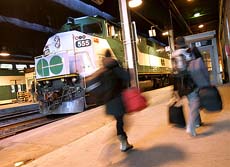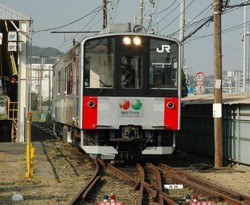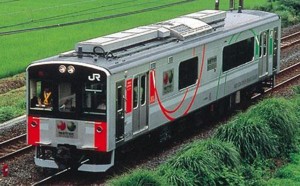HYDRAIL: MEDIA RELEASE
This page undergo frequent updates.
31 March 2008
Indonesia offers high-speed train project on crowded Java
The Indonesian government is offering to international investors the
high-speed train project connecting the two largest cities of Jakarta
and Surabaya, local press said Monday. The 683-km railway project is
estimated to cost 6.14 billion U. S. dollars, which the government is
unable to spare from the state budget, reported leading economic daily
Bisnis Indonesia, quoting a senior official from the Transportation
Ministry. The government promised various incentives and privileges for
investors willing to build the railway and operate the high-speed
train, which could travel between the two cities in just three hours. Source: Xinhua News Agency
31 March 2008
Indonesian High Speed Train Project Offered to Investor
Indonesia's Transport Ministry has offered investors the chance to
build a US$6.14 billion project of high speed trains and tracks
covering a distance of 683 kilometers between Jakarta and Surabaya in
East Java. Railway Director General Wendy Aritenang Yazid said the
government will facilitate the process of securing the license and
guarantee legal certainty for investor agreeing to build and operate
the project. Prospective investors may build and operate the project
without involving the state-owned railway company PT Kereta Api, Yazid
said. She said the tracks for high speed train may be built over unused
land along the existing railway tracks of PT KA. She said the investors
have to be involved as the project could not come to reality by relying
on the cash strapped government. A feasibility study carried out by
French railway company Societe Nationale des Chemins de Fer (SCNF) says
the high speed train could cover the distance in three hours as against
more than 10 hours normally. Investors from France, Japan and South
Korea have indicated interest in the project. Source: Investment Coordinating Board of the Republic of Indonesia
01 January 2008
Demonstrating the power of hydrogen
IMAGINE a train which is nearly silent, whose only exhaust is pure
water. A train without overhead wires, running on fuel produced using
renewable energy. But this is no futuristic dream - the VLTJ Hydrogen
Train Project aims to launch Europe's first hydrogen fuel cell train in
2010. The consortium behind the project currently includes Vossloh, the
University of Salerno, Strandmøllen Industrigas, Dana Tank, Denmark's
Hydrogen Innovation & Research Centre, the UK's Rail Safety &
Standards Board, and Danish independent railway VLTJ. Hydrogen fuel
cells have a lower energy efficiency then conventional electrification,
due to the conversion losses in hydrogen production (electrolysis has
an 80% efficiency), hydrogen storage (90%), the fuel cell (45%) and
electric motor (90%). But hydrogen fuel produced using renewable energy
will still have an overall energy efficiency comparable to diesel
traction at roughly 30%, and that is before we take into account the
considerable gains that can be achieved through the use of regenerative
braking. Hydrogen for railway use can be produced by electrolysis of
water, with the environmental benefits dependent on the method of
electricity generation, which can include renewable sources such as
wind turbines. Surplus industrial hydrogen is a shorter-term source of
fuel, and both options are currently available at the project site (more ...).
Source: Railway Gazette
21 October 2007
All aboard the GO hydrogen express
 ONTARIO, Canada: Now that the provincial Liberals have secured another
four years in office, it's fair to ask whether Premier Dalton
McGuinty's recent talk of locally manufactured, hydrogen-powered GO
trains was just election rhetoric or a serious, forward-looking
strategy to nurture innovation and create jobs. McGuinty revealed last
month that his government was in early-stage talks with Bombardier to
design and develop an emission-free commuter train propelled by
hydrogen-powered fuel cells and used by GO Transit. Niche fuel-cell
markets have also emerged, costs are slowly falling, and storage
technologies are improving, even if profitability remains elusive. Fuel
cells running on hydrogen are gaining traction for back-up power, while
micro fuel cells are poised to appear in portable commercial
electronics. Ballard Power and several other companies, meanwhile, have
made a strong business case for using fuel cells to power forklifts (more ...).
Source: The Star
19 Oct 2006
JR tests fuel cell hybrid train
ONTARIO, Canada: Now that the provincial Liberals have secured another
four years in office, it's fair to ask whether Premier Dalton
McGuinty's recent talk of locally manufactured, hydrogen-powered GO
trains was just election rhetoric or a serious, forward-looking
strategy to nurture innovation and create jobs. McGuinty revealed last
month that his government was in early-stage talks with Bombardier to
design and develop an emission-free commuter train propelled by
hydrogen-powered fuel cells and used by GO Transit. Niche fuel-cell
markets have also emerged, costs are slowly falling, and storage
technologies are improving, even if profitability remains elusive. Fuel
cells running on hydrogen are gaining traction for back-up power, while
micro fuel cells are poised to appear in portable commercial
electronics. Ballard Power and several other companies, meanwhile, have
made a strong business case for using fuel cells to power forklifts (more ...).
Source: The Star
19 Oct 2006
JR tests fuel cell hybrid train
 On October 19, East Japan Railway Company (JR East) made a test run of
its NE Train (New Energy Train) — the world’s first fuel cell hybrid
train — in Yokohama’s Kanazawa ward. With two 65-kilowatt fuel cells
and six hydrogen tanks under the floor and a secondary battery on the
roof, the clean train emits only water and runs without receiving juice
from power lines. The train can travel at a maximum speed of 100 kph
(60 mph) for 50 to 100 km (30 to 60 miles) without a hydrogen refill
Thirty passengers boarded the train for the test run, which consisted
of a series of back-and-forth jaunts along a 300-meter test track. The
train smoothly accelerated to a maximum speed of 50 kph (30 mph),
providing a ride quality no different from an ordinary train. A
separate fuel cell train is under development by the Railway Technical
Research Institute (RTRI), but the NE Train differs in that it is a
hybrid relying on a secondary battery that stores electricity generated
during braking. The secondary battery provides auxiliary power during
acceleration or when fuel cell power is insufficient. JR East hopes to
see hybrid commuter trains in widespread use in 10 to 20 years.
Lowering the cost and improving the mileage of fuel cells is a serious
challenge, but the effort is not without reward. In addition to
environmental benefits, eliminating the need for unsightly power lines
means lower infrastructure costs and a prettier landscape to look at
from the train window. Testing of the train on public tracks will begin
next April. Source: Chunichi Shimbun
03 August 2006
Hydrogen on Track
Vehicle Projects, spun out of the Colorado School of Mines, in Golden,
is recognized as the first company to have built a fuel-cell
locomotive. Its earlier 3.6-metric-ton, 17-kilowatt hydrogen-powered
mine locomotive—for which Nuvera also supplied PEM fuel cell stacks—was
completed in 2002 and demonstrated in a working mine in Ontario [see
photo, “Little Workhorse”]. “We retrofitted a battery-powered
locomotive, because it already had an electric drive,” says Miller.
Miller says that the mine locomotive served as a proof of concept for
all that needs to be verified in a fuel-cell vehicle. Is it safe? Can
you easily and regularly refuel the vehicle? Does it deliver enough
power for industrial, commercial, and commuter applications? Compared
with the battery-powered locomotive it replaced, he says, “it had twice
the power and could be refueled with hydrogen in 30 to 45 minutes, as
opposed to 8 hours.” RTRI is planning a two-car locomotive—one carrying
electric motors, a transformer, and a battery charged by regenerative
braking, and the other holding fuel-cell stacks and a hydrogen storage
cylinder. The train’s top speed will be 120 kilometers per hour, and it
will travel 300 to 400 km before its hydrogen needs replenishing.
Officials say they hope to have the train ready by 2010, and a
prototype, with one-fourth the propulsion power of the proposed final
version, is already being tested. Japan Rail East says a hybrid
locomotive that it is designing will get about one-third of its
propulsion power from two 65-kW electric motors driven by onboard fuel
cells and the rest from a diesel engine. It will start traversing the
mountainous Nagano and Yamanashi prefectures west of Tokyo by the
summer of 2007 (more ...).
Source: IEEE Spectrum
03 July 2006
'Hydrail' Picking Up Steam: The Push for a Commuter Train Run on Fuel Cells
Jul. 1--He's been toasted in Denmark and hailed as a visionary, and he
helped coin a word, "hydrail," that already gets more than 2,000 Google
hits. That's just the beginning of Stan Thompson's dream. The retired
BellSouth strategic planner believes Charlotte can become the first
U.S. city to run a hydrogen-powered commuter train. The locomotive
would operate on fuel cells that use hydrogen and oxygen to make
electricity, leaving behind only water vapor. Fuel cells aren't
scientific fantasy. NASA has used them since the 1960s to power
spacecraft, and they're being tested for such things as airport
vehicles and forklifts. But practical problems have so far blocked
their most widely sought use: in cars.The cells are expensive, and
their durability is untested. Hydrogen is costly to extract and bulky
to store. Fueling infrastructure doesn't exist (more ...).
Source: Fuel Cell Today
05 Apr 2006
Japan Railways to test world’s first fuel cell-powered train
On October 19, East Japan Railway Company (JR East) made a test run of
its NE Train (New Energy Train) — the world’s first fuel cell hybrid
train — in Yokohama’s Kanazawa ward. With two 65-kilowatt fuel cells
and six hydrogen tanks under the floor and a secondary battery on the
roof, the clean train emits only water and runs without receiving juice
from power lines. The train can travel at a maximum speed of 100 kph
(60 mph) for 50 to 100 km (30 to 60 miles) without a hydrogen refill
Thirty passengers boarded the train for the test run, which consisted
of a series of back-and-forth jaunts along a 300-meter test track. The
train smoothly accelerated to a maximum speed of 50 kph (30 mph),
providing a ride quality no different from an ordinary train. A
separate fuel cell train is under development by the Railway Technical
Research Institute (RTRI), but the NE Train differs in that it is a
hybrid relying on a secondary battery that stores electricity generated
during braking. The secondary battery provides auxiliary power during
acceleration or when fuel cell power is insufficient. JR East hopes to
see hybrid commuter trains in widespread use in 10 to 20 years.
Lowering the cost and improving the mileage of fuel cells is a serious
challenge, but the effort is not without reward. In addition to
environmental benefits, eliminating the need for unsightly power lines
means lower infrastructure costs and a prettier landscape to look at
from the train window. Testing of the train on public tracks will begin
next April. Source: Chunichi Shimbun
03 August 2006
Hydrogen on Track
Vehicle Projects, spun out of the Colorado School of Mines, in Golden,
is recognized as the first company to have built a fuel-cell
locomotive. Its earlier 3.6-metric-ton, 17-kilowatt hydrogen-powered
mine locomotive—for which Nuvera also supplied PEM fuel cell stacks—was
completed in 2002 and demonstrated in a working mine in Ontario [see
photo, “Little Workhorse”]. “We retrofitted a battery-powered
locomotive, because it already had an electric drive,” says Miller.
Miller says that the mine locomotive served as a proof of concept for
all that needs to be verified in a fuel-cell vehicle. Is it safe? Can
you easily and regularly refuel the vehicle? Does it deliver enough
power for industrial, commercial, and commuter applications? Compared
with the battery-powered locomotive it replaced, he says, “it had twice
the power and could be refueled with hydrogen in 30 to 45 minutes, as
opposed to 8 hours.” RTRI is planning a two-car locomotive—one carrying
electric motors, a transformer, and a battery charged by regenerative
braking, and the other holding fuel-cell stacks and a hydrogen storage
cylinder. The train’s top speed will be 120 kilometers per hour, and it
will travel 300 to 400 km before its hydrogen needs replenishing.
Officials say they hope to have the train ready by 2010, and a
prototype, with one-fourth the propulsion power of the proposed final
version, is already being tested. Japan Rail East says a hybrid
locomotive that it is designing will get about one-third of its
propulsion power from two 65-kW electric motors driven by onboard fuel
cells and the rest from a diesel engine. It will start traversing the
mountainous Nagano and Yamanashi prefectures west of Tokyo by the
summer of 2007 (more ...).
Source: IEEE Spectrum
03 July 2006
'Hydrail' Picking Up Steam: The Push for a Commuter Train Run on Fuel Cells
Jul. 1--He's been toasted in Denmark and hailed as a visionary, and he
helped coin a word, "hydrail," that already gets more than 2,000 Google
hits. That's just the beginning of Stan Thompson's dream. The retired
BellSouth strategic planner believes Charlotte can become the first
U.S. city to run a hydrogen-powered commuter train. The locomotive
would operate on fuel cells that use hydrogen and oxygen to make
electricity, leaving behind only water vapor. Fuel cells aren't
scientific fantasy. NASA has used them since the 1960s to power
spacecraft, and they're being tested for such things as airport
vehicles and forklifts. But practical problems have so far blocked
their most widely sought use: in cars.The cells are expensive, and
their durability is untested. Hydrogen is costly to extract and bulky
to store. Fueling infrastructure doesn't exist (more ...).
Source: Fuel Cell Today
05 Apr 2006
Japan Railways to test world’s first fuel cell-powered train
 On April 4, the East Japan Railway Company reported progress in the
development of the world’s first fuel cell-powered train. With the
prototype nearing completion, the company announced plans to begin
trial runs in order to collect data before putting the train into
commercial service. According to officials, the test train consists of
one car and is powered by two 65kW fuel cells that enable speeds of up
to 100 kph (60 mph). The train is an upgraded version of JR’s New
Energy (NE) train — an experimental diesel-electric hybrid developed in
2003 — whose diesel generator has been replaced with fuel cells. The
new fuel cell-powered NE train is scheduled to begin service in the
summer of 2007 on the rural, non-electrified Koumi Line in Nagano and
Yamanashi prefectures. Hydrogen stored in a tank aboard the train is
supplied to the fuel cells, where it reacts with oxygen to produce
electricity. Unused electricity and electricity generated during
braking is stored in a secondary battery, which is used as an auxiliary
power source. In addition to being energy-efficient, hydrogen fuel
cells emit no carbon dioxide (a contributor to global warming), only
water. Source: Fuji Senkai Business
On April 4, the East Japan Railway Company reported progress in the
development of the world’s first fuel cell-powered train. With the
prototype nearing completion, the company announced plans to begin
trial runs in order to collect data before putting the train into
commercial service. According to officials, the test train consists of
one car and is powered by two 65kW fuel cells that enable speeds of up
to 100 kph (60 mph). The train is an upgraded version of JR’s New
Energy (NE) train — an experimental diesel-electric hybrid developed in
2003 — whose diesel generator has been replaced with fuel cells. The
new fuel cell-powered NE train is scheduled to begin service in the
summer of 2007 on the rural, non-electrified Koumi Line in Nagano and
Yamanashi prefectures. Hydrogen stored in a tank aboard the train is
supplied to the fuel cells, where it reacts with oxygen to produce
electricity. Unused electricity and electricity generated during
braking is stored in a secondary battery, which is used as an auxiliary
power source. In addition to being energy-efficient, hydrogen fuel
cells emit no carbon dioxide (a contributor to global warming), only
water. Source: Fuji Senkai Business
